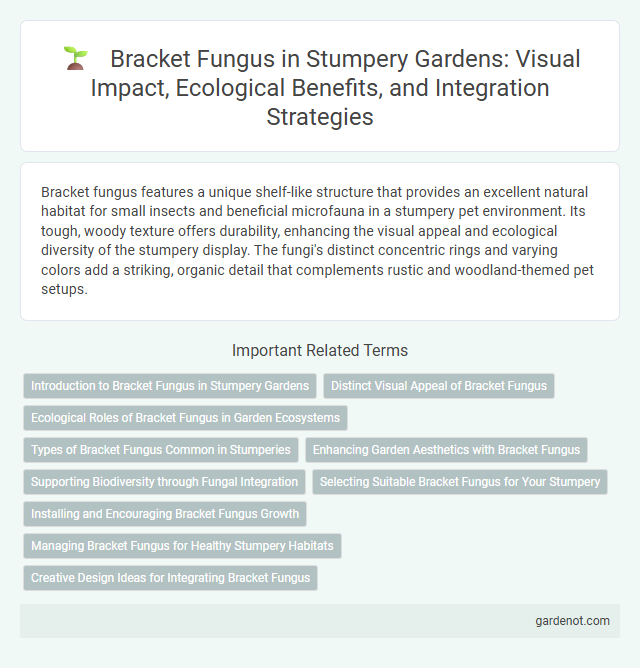Bracket fungus features a unique shelf-like structure that provides an excellent natural habitat for small insects and beneficial microfauna in a stumpery pet environment. Its tough, woody texture offers durability, enhancing the visual appeal and ecological diversity of the stumpery display. The fungi's distinct concentric rings and varying colors add a striking, organic detail that complements rustic and woodland-themed pet setups.
Introduction to Bracket Fungus in Stumpery Gardens
Bracket fungi, known for their shelf-like growth on decaying wood, play a crucial role in stumpery gardens by enhancing biodiversity and providing natural, textured features. These fungi contribute to the decomposition process, enriching soil quality and supporting various woodland organisms. Their distinctive, layered appearance creates visual interest and highlights ecological interactions within the stumpery landscape.
Distinct Visual Appeal of Bracket Fungus
Bracket fungus showcases a distinct visual appeal through its layered, shelf-like growth patterns and vibrant hues ranging from deep browns to striking oranges and whites. Its tough, woody texture contrasts with the soft, mossy surroundings, creating a dramatic focal point in any stumpery. The unique fan-shaped formations contribute to biodiversity, attracting various insects and enhancing the ecological complexity of shaded woodland gardens.
Ecological Roles of Bracket Fungus in Garden Ecosystems
Bracket fungi play a vital role in garden ecosystems by decomposing dead wood, recycling nutrients essential for plant growth. Their ability to break down tough lignin and cellulose contributes to soil health, promoting biodiversity among soil microbes and invertebrates. Acting as natural recyclers, bracket fungi support the stability and sustainability of garden habitats.
Types of Bracket Fungus Common in Stumperies
Common types of bracket fungus found in stumperies include Turkey Tail (Trametes versicolor), known for its vibrant, concentric color bands, and Artist's Bracket (Ganoderma applanatum), which features a smooth upper surface and a white underside that darkens when scratched. Other frequent varieties are the Red-Belted Bracket (Fomitopsis pinicola), recognizable by its reddish band, and the Birch Polypore (Piptoporus betulinus), often growing on birch stumps and utilized for its medicinal properties. These fungi contribute to the ecological diversity and aesthetic appeal of stumperies by decomposing wood and providing habitats for various woodland creatures.
Enhancing Garden Aesthetics with Bracket Fungus
Bracket fungus adds a unique, natural texture and visual interest to stumperies, transforming garden spaces into captivating woodland-inspired showcases. Their layered, shelf-like growth patterns create striking focal points on tree stumps and decaying wood, complementing mosses and ferns for a harmonious, eco-friendly aesthetic. Incorporating diverse bracket fungus species enriches the biodiversity and artistic appeal of garden designs, emphasizing sustainable horticulture.
Supporting Biodiversity through Fungal Integration
Bracket fungus, a key component of stumperies, enhances biodiversity by providing essential habitats and food sources for numerous invertebrates and microorganisms. Its integration into stumpery design promotes nutrient cycling and soil health through fungal decomposition processes. This symbiotic relationship supports diverse ecosystems, fostering resilient and sustainable woodland environments.
Selecting Suitable Bracket Fungus for Your Stumpery
Selecting suitable bracket fungus for your stumpery involves choosing species with visually striking shapes, colors, and textures that complement the natural wood elements. Commonly sought after varieties include Ganoderma, Fomes fomentarius, and Trametes versicolor, prized for their distinctive shelf-like formations and resilience in outdoor environments. Prioritize fungi that thrive in your local climate and on the types of wood present, ensuring a sustainable and attractive addition to your stumpery landscape.
Installing and Encouraging Bracket Fungus Growth
Bracket fungus thrives on decaying wood, making it essential to install logs or tree stumps with suitable moisture levels in shaded, humid areas of the stumpery. Encouraging growth involves selecting hardwood species like oak or beech, inoculating with bracket fungus spores or plugs, and maintaining consistent damp conditions to promote fungal colonization. Regular monitoring for fungal spread and avoiding disturbance to established mycelium ensures sustainable bracket fungus development.
Managing Bracket Fungus for Healthy Stumpery Habitats
Managing bracket fungus in stumperies involves monitoring fungal growth to maintain ecological balance and wood decay processes vital for habitat diversity. Regular inspection and selective removal of excessive bracket fungi prevent structural damage to stumps while supporting beneficial decomposition. Encouraging a diversity of bracket fungus species enhances nutrient cycling and provides food sources for invertebrates, fostering a healthy stumpery ecosystem.
Creative Design Ideas for Integrating Bracket Fungus
Bracket fungus offers unique textural and structural elements perfect for creative stumpery designs, adding natural sculptures that enhance woodland aesthetics. Incorporating bracket fungi into stumperies provides diverse shapes and colors that mimic miniature shelves and organic wall art, enriching visual interest. Using clusters of bracket fungus around moss, ferns, and decaying wood creates dynamic, low-maintenance garden displays that highlight ecological beauty.
Bracket fungus feature Infographic

 gardenot.com
gardenot.com